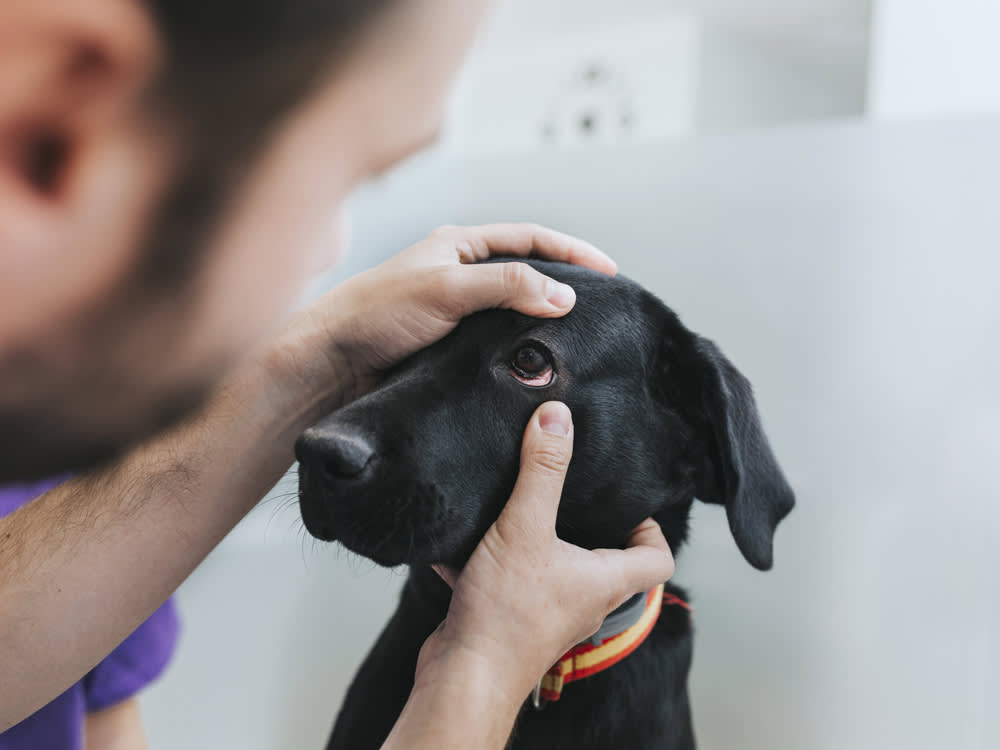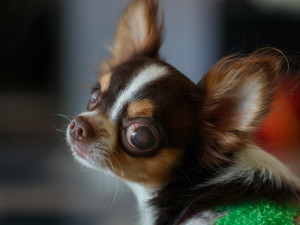What’s This Weird Red Bump On My Dog’s Eye?
That would be a cherry eye, and you’ll want to see your vet.

share article
If your dog is sporting a red, swollen bump in the corner of their eye that’s causing cloudiness and discharge, it’s likely cherry eye — a concerning but not uncommon health issue in pups. Keep reading to learn what causes cherry eye in dogs, plus what to do if you think your pup has it.
What Is Cherry Eye in Dogs?
To understand what cherry eye is, it helps to know the structure of your dog’s eyes. Unlike humans, who have two eyelids, dogs have three. The third eyelid rises from the inner corner of the eye and covers the eye diagonally to lubricate it — so it’s important that it functions properly. Cherry eye in dogs occurs when the third eyelid gland slips out of place, creating the appearance of a swollen red mass. The red mass may be constant or transient (meaning it comes and goes). Luckily, it isn’t terribly painful, the symptoms are easy to notice and if treated quickly, there are usually no long-lasting effects. If ignored, surgery may be required to treat cherry eye in order to prevent permanent long-term eye problemsopens in a new tab in your pup, like decreased tear production.
Dr. Sean Collins, a clinical assistant professor at the Texas A&M University College of Veterinary Medicine & Biomedical Sciences, says that ophthalmologists don’t entirely understand why that third eyelid sometimes slips from its original position. While any dog breed can develop cherry eye, it is seen most commonly in breeds such as American Cocker Spaniels, Bassett Hounds, Beagles, Boston Terriers, English Bulldogs, Lhasa Apsos, Pekinese, Shih Tzus and other brachycephalic (flat-faced) breeds.
Signs of Cherry Eye
A pink or red round bulge in the corner of the dog’s eye
Eye irritation, attempts to paw at the eye
Difficulty closing the eye
Eye discharge
What to Do if Your Dog Has Cherry Eye
If you spot a red swollen bulge in the inner corner of your dog’s eye, large or small, call your vet immediately. In addition to causing irritation to the dog, cherry eye can have lasting consequences if left untreated. “Without correction, chronic prolapse can lead to conjunctivitis in dogs (pink eye) and eye discharge,” explains Collins. “It has also been shown that with correction, dogs are less likely to develop low tear production later in life.”
Low tear productionopens in a new tab can result in a set of its own problems — along with decreased vision, your dog may develop a corneal ulceration which can cause an eye infection and result in a ruptured eye. This condition responds well to tear stimulant therapy in most cases, but lifelong medication is usually required. Your veterinarian will be able to confirm whether your pet has cherry eye and can develop a treatment plan that works best to resolve the issue and reduce the potential for future eye issues.
How is Cherry Eye in Dogs Treated?
“Initial therapy may consist of a topical anti-inflammatory,” says Dr. Collins, especially if local inflammation is contributing to the prolapse. He adds that if initial treatment doesn’t work or a prolapse returns, surgery may be required. “There are numerous surgical techniques to reposition the gland with overall high success rates.” If your dog’s cherry eye is transient, your vet may wait until it is in constant prolapse before providing surgical treatment.
The most effective treatment for cherry eyeopens in a new tab in dogs involves surgical repositioning of the gland back to its proper location, says veterinarian Dr. Wendy Brooks. There are currently two surgical techniques to do this. The most commonly performed technique is traditional tucking (also called tacking), where a single permanent stitch is placed, pulling the gland back to position. However, in a newer surgical method called imbrication, a wedge of tissue is removed from above the affected gland. This new technique is more challenging and uses several tiny temporary stitches to close the gap.
The third eyelid’s tear gland is responsible for about 30-50% of the tear production in dogs. If the initial medical therapy is unsuccessful, surgical reposition is key to preserving tear production. In fact, dogs that have undergone surgical repositioning of the gland have a lower chance of developing dry eye than dogs who are chronically prolapsed.
How to Prevent Cherry Eye in Dogs
Unfortunately, there are no known preventative measures to avoid cherry eye, according to Dr. Collins. About 40% of dogs that experience cherry eye will be affected in both eyes, usually before the age of two. The best way to protect your pup from problems is to remain vigilant in monitoring their health, promptly bringing any concerns to your vet. To preserve your dog’s eye health, cherry eye should be addressed early when it’s most easily treated.
If your dog seems to have cherry eye, take them to the vet right away. Your vet may have the knowledge and equipment to diagnose and treat the problem immediately. If not, you may be referred to a veterinary ophthalmologist who specializes in animal eyes and their disorders.

Jennifer Gauntt
Jennifer Gauntt, MA, is the communications director at Texas A&M University College of Veterinary Medicine & Biomedical Sciences, where she covers scientific advancements in pet heath and behavior. This story was originally published by Pet Talk, a service of the College of Veterinary Medicine & Biomedical Sciences, Texas A&M University. Original stories can be viewed on the web at vetmed.tamu.edu/news/pet-talkopens in a new tab. May be edited for style and length.

